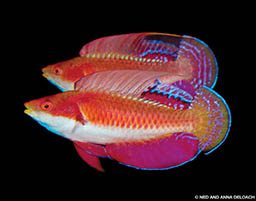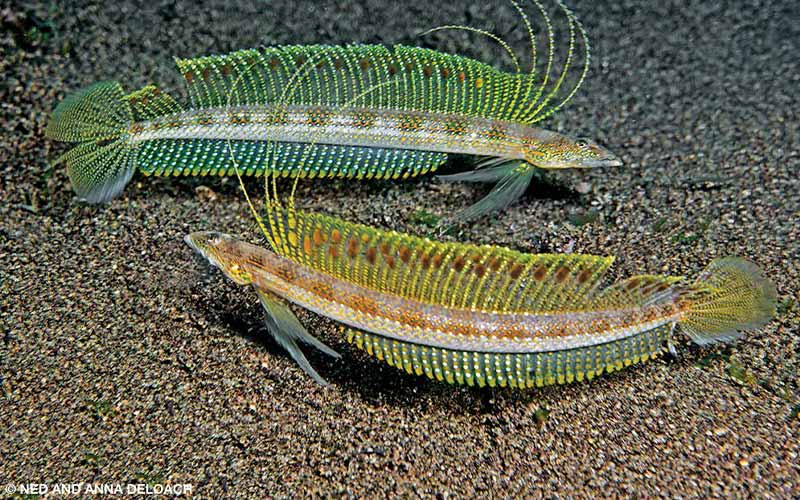This spring Anna and I spent much of our underwater time looking for beautiful fishes being as beautiful as they could be — a hallmark of sexual selection. We came away with an eyeful of dazzle and were once again reminded that when it comes to interpreting animal behavior, things are seldom as straightforward as they seem.

Charles Darwin introduced the concept of sexual selection along with its central tenet, female choice, in his 1871 publication The Descent of Man, and Selection in Relation to Sex. The book appeared just as the educated public was beginning to accept his mind-altering idea of evolution by natural selection, published a decade earlier in On the Origin of Species. But this time around, Darwin’s conclusion that peahens (or any other females) could hold the trump card in the selection of mates was too much for the male mind of Victorian times. Perhaps even more unsettling to his readers was the idea that female animals choose mates for beauty’s sake. This flew in the face of most people’s understanding of natural selection, in which conspicuous adaptations such as a peacock’s showy feathers would get you killed. Naturalists of Darwin’s day accepted the use of oversized features such as antlers as weapons to fight for females, and that was about as far as serious thinking on the matter went for the next hundred years.
Rekindled interest in sexual selection in recent decades, coupled with the advent of computerized number crunching, support much of Darwin’s early writings. Without question, females of many species select mates based on an array of eccentric features: croaks for frogs, enlarged tail feathers for birds and flashy fins for fish. Research shows that despite these potentially life-inhibiting encumbrances, males with the loudest croaks, the longest plumage and the most elaborate fins enjoy superior reproductive success. The precise reason the females of many species choose beautiful mates has been distilled down to two schools of thought: Either peahens and their ilk are on genetic treadmills to produce ever-sexier sons that in turn produce ever-sexier sons, or as the competing argument goes, bright colors and ornamental handicaps are reliable indicators of good health. Whichever way one looks at it, we’re happy to report that the use of flamboyant displays and courtship rituals (which predate the dinosaurs) are alive and well beneath the sea.

We began by snooping around at Lembeh Strait, a 12-mile stretch of Indonesian ocean that Anna and I have been visiting since 1999. One of the strait’s highlights just happens to be flasher and fairy wrasses — the ocean’s answer to the peacock’s tail. Although fairly common throughout the Indo-Pacific, the lovely wrasses are easy to overlook. For much of the day the two-inch males and the smaller unadorned females slink around algae- or rubble-covered terrain below 50 feet with their colors muted and their fins collapsed. All this changes for 20 spirited minutes in the late afternoon when the wrasses, powered by sexual selection, go into their reproductive mode.
The daily event begins subtly as egg-swollen females congregate in small clusters. Within seconds, males flying their gaudiest colors blast off from the bottom like testosterone-fueled fighter jets. At the peak of the action it is difficult to sort out exactly what is happening. This is even the case later when we slow down Anna’s video, but from what we can make out, the most lavishly adorned males appear as intent on using their ornamentation to intimidate rival males as to woo females. It often seemed to us that the most brilliant colors, tautest fins and greatest speeds belong to males that race side by side in contests of comparative beauty. As it turns out, these dramatic displays help establish and maintain favored reproductive status among competitive males, mitigating the use of life-threatening combat.
Next we tracked down a colony of sand divers — small, colorful, soda-straw-thin fishes sporting awkwardly large fins. Like flasher wrasses, male sand divers also show off for females and compete with rivals. Instead of dashing about as apparent mirror images of one another, antagonistic males spin around each other in carousels of colors.
One late afternoon we settle in on a most puzzling bit of stagecraft that once again ran contrary to our expectations of sexual selection. Inside a shallow pocket of coral, three male mandarinfish, flaunting their pretty-boy best, bobbed together for several minutes. There was no nipping, no bluster and no tension. The finely costumed trio appeared as companionable and self-assured as the dandy Dutchmen in Rembrandt’s The Night Watch. All we could do was watch and wonder — so that was exactly what we did.
© Alert Diver — Q3 Summer 2016